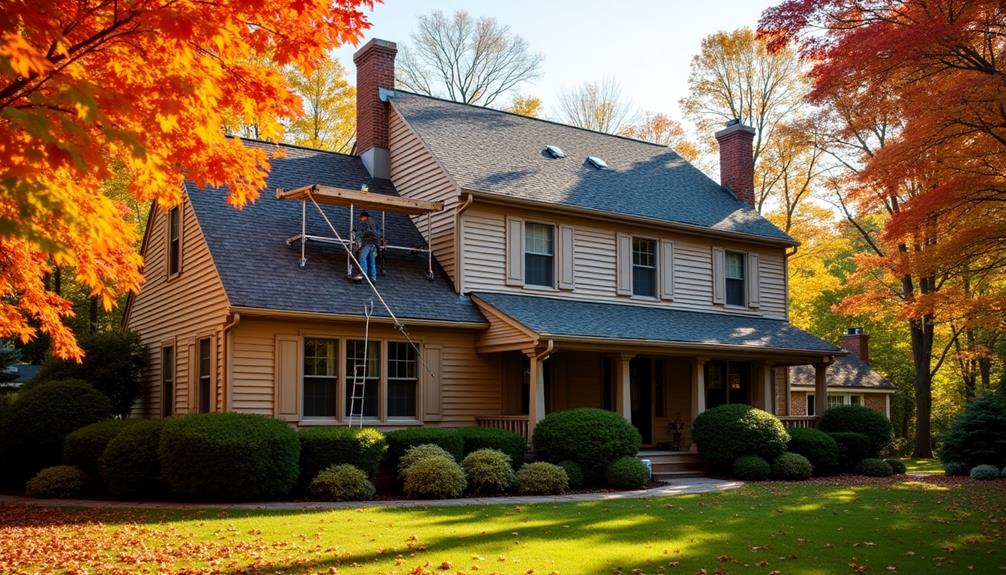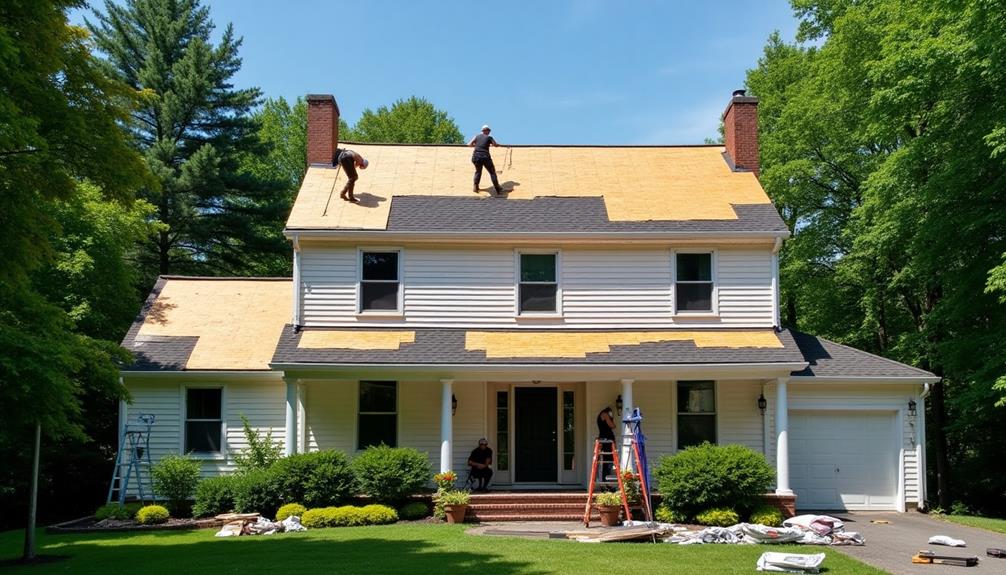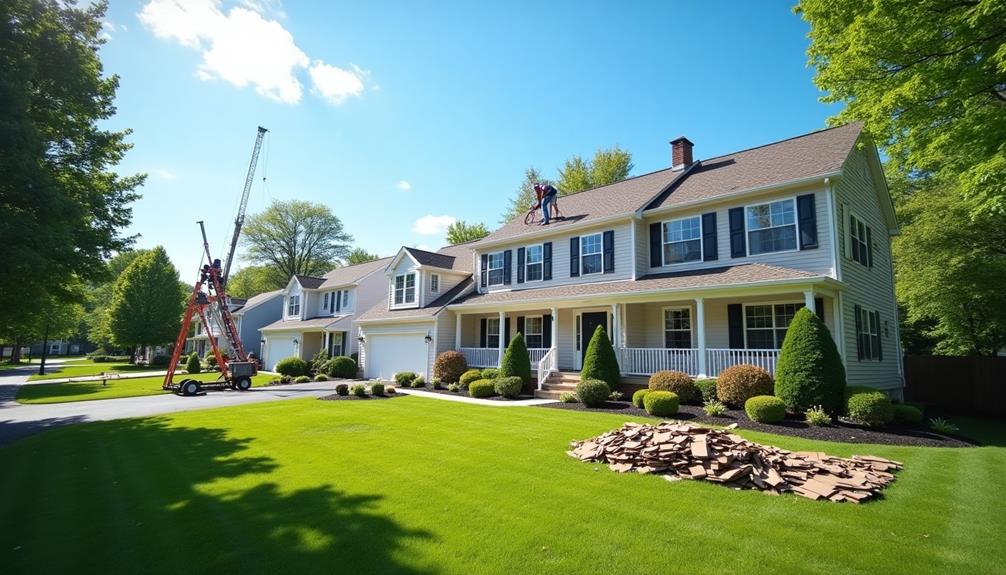When you're gearing up for a roof inspection, it's crucial to take a few preparatory steps that can make the process smoother and more efficient. Start by scheduling the inspection on a clear day, and don't forget to inform your tenants and neighbors. Clearing the area of debris and ensuring safe access can significantly impact the inspector's ability to do their job. You might also want to take a moment to inspect from the ground for any visible issues. But what else should you consider to ensure everything goes off without a hitch?
Understand the Inspection Process
Before your roof inspection, it's essential to understand what the process involves. Knowing what to expect can help you feel more prepared and informed. A typical inspection starts with the inspector reviewing your roof's exterior and interior components.
An inspection checklist is often used to ensure that no detail is overlooked. This checklist will typically cover aspects like shingles, flashing, gutters, and ventilation systems.
It's also crucial to consider the inspector qualifications. Make sure your inspector has the necessary certifications and experience. A qualified inspector should have a solid understanding of various roofing materials and systems. They should also be familiar with local building codes and regulations, which can vary significantly.
During the inspection, the inspector will assess the roof for signs of damage, wear, and potential leaks. They'll take notes and may even photograph areas of concern.
After the inspection, you'll receive a detailed report outlining their findings, which can help you plan any necessary repairs or maintenance. By understanding this process, you can have a more productive and insightful inspection experience.
Schedule the Inspection
When you schedule the roof inspection, pick a date that works best for you and your routine.
Make sure to notify anyone who might need to be present, like family members or tenants. This way, everyone is prepared, and the inspection can go smoothly.
Choose a Suitable Date
Choosing a suitable date for your roof inspection is crucial to ensuring a thorough evaluation of your roof's condition. You'll want to take weather conditions into account, as rain or snow can hinder visibility and impede the inspector's ability to assess your roof properly.
Scheduling during clear weather allows for a more accurate evaluation and helps avoid any potential safety hazards.
Additionally, think about seasonal considerations. For instance, if you live in an area with heavy snowfall, scheduling your inspection in late spring or early summer might be ideal. This timing allows any winter damage to be more evident and gives you the chance to address repairs before the next winter season arrives.
Moreover, consider your own availability and the inspector's schedule. The best time is often when you can be present, allowing you to ask questions and receive immediate feedback.
Overall, picking a clear, dry day during a suitable season will result in a more effective roof inspection, ultimately helping you maintain your roof and protect your home.
Notify Relevant Parties
Once you've settled on a suitable date for your roof inspection, it's time to notify all relevant parties involved.
Clear communication ensures everyone is prepared and minimizes any disruptions. Here's who you should reach out to:
- Notify tenants: If you rent out your property, make sure your tenants are aware of the inspection date. This gives them ample time to prepare.
- Inform neighbors: Let your neighbors know about the inspection, especially if it might cause noise or disturbances. A friendly heads-up can strengthen community relations.
- Contact the roofing company: Confirm the date and time with the roofing contractor. Ensure they've all necessary access and information.
- Check with local authorities: Depending on your municipality, you might need to inform local authorities if there are any permits involved.
Clear the Surrounding Area
Before the roof inspector arrives, make sure to clear the surrounding area of any obstacles that could hinder their work. Start with debris removal; pick up leaves, branches, or any trash that's piled up near the base of your home. This not only creates a safer environment for the inspector but also allows for a thorough examination of the roof and its drainage systems.
Next, focus on space organization. Move any equipment, tools, or outdoor furniture away from the inspection site. If you have ladders or scaffolding, ensure they're stored safely and out of the way. This will give the inspector easy access to all areas of your roof and the surrounding ground, which is crucial for a complete assessment.
Additionally, if you have vehicles parked close to your home, consider relocating them to provide ample space for the inspector to maneuver. A clear and organized space will facilitate a more efficient inspection process, helping to identify any issues quickly.
Trim Overhanging Branches
To ensure a thorough roof inspection, you'll want to assess how close overhanging branches are to your roof.
Use the right tools to trim them back safely, keeping in mind the importance of safety precautions.
This will help prevent damage during the inspection and maintain your roof's integrity.
Assess Branch Proximity
When preparing for a roof inspection, it's crucial to assess the proximity of branches to your roof. Overhanging branches can pose serious risks, including damage during storms or pest invasions.
Prioritizing branch safety is essential, not just for your roof's integrity, but also for the overall health of your trees.
To effectively evaluate the situation, consider the following:
- Distance: Ensure branches are at least 10 feet away from your roof.
- Health: Check for dead or diseased branches that may fall and cause damage.
- Height: Assess the height of trees near your roof; taller trees can create larger risks during high winds.
- Growth: Monitor how quickly branches grow; regular tree maintenance can help prevent future issues.
Use Proper Tools
Using the right tools is essential for effectively trimming overhanging branches and ensuring your roof remains protected. Start with a sturdy pair of pruning shears or loppers to cut small to medium branches. If you're dealing with larger branches, a chainsaw might be necessary. Make sure to choose tools that are well-maintained to ensure clean cuts, which helps prevent damage to your roofing materials.
Additionally, consider using a pole saw for branches that are out of reach. This tool allows you to keep a safe distance from the edge of your roof while still getting the job done. It's important to have a sturdy ladder on hand, too, if you need to access higher areas.
Always inspect your tools before use, as worn-out or damaged inspection tools can lead to accidents.
Lastly, after trimming, collect any fallen debris to avoid clogging gutters or creating hazards around your home. Keeping your roof free from overhanging branches not only protects your roofing materials but also enhances the overall safety and longevity of your roof.
Make sure you're equipped with the right tools to tackle this task effectively.
Safety Precautions First
Before you start trimming overhanging branches, prioritizing safety is crucial. You want to ensure both personal safety and equipment safety to prevent accidents that could lead to injuries or damage.
Follow these essential precautions to make the process smoother and safer:
- Wear protective gear: Use safety goggles, gloves, and a hard hat to shield yourself from falling debris.
- Check your tools: Inspect all equipment for any damage or wear before using them. Properly maintained tools are less likely to fail and cause accidents.
- Secure your ladder: If you're using a ladder, ensure it's on stable ground and secured to prevent slipping. Don't lean too far to one side.
- Be aware of your surroundings: Look out for power lines or any other hazards in the area. Make sure the space below is clear of people and pets.
Inspect From the Ground
Inspecting from the ground is a crucial first step in assessing your roof's condition. Before climbing up, take a moment to observe your roof from below. Look for any obvious signs of damage, like missing shingles, sagging areas, or discoloration. These can indicate underlying issues that need attention.
During your ground inspection, use binoculars to get a closer view of hard-to-reach spots. Check the edges of the roof, around chimneys, and near vents. Pay attention to any debris, such as leaves or branches, which can trap moisture and lead to deterioration over time.
Don't forget to inspect the gutters and downspouts, as clogs can cause water to back up and damage your roof. If you notice any unusual wear or damage, it's essential to document these findings for later reference.
Document Previous Repairs
Before your roof inspection, it's crucial to document any previous repairs.
Gather all relevant receipts and create an overview of your repair history to provide the inspector with a clear picture of your roof's condition.
This information can help identify any ongoing issues and guide the inspection process.
Repair History Overview
When preparing for a roof inspection, documenting your roof's repair history is crucial. This overview helps the inspector understand the condition of your roof and any potential issues that may arise.
A clear repair timeline and maintenance records will provide valuable insights into what's been done and what may need attention.
Make sure to include the following details in your repair history overview:
- Date of repairs: Note when each repair was completed for a clear timeline.
- Types of repairs: Specify what repairs were made, such as shingle replacements, leak fixes, or structural work.
- Contractor information: Record the names of contractors or companies that performed the repairs, including contact information.
- Warranty details: If any repairs came with a warranty, make a note of the terms and expiration dates.
Gather Relevant Receipts
Having a comprehensive repair history is just the beginning; gathering relevant receipts is equally important for documenting previous repairs. These receipts provide concrete evidence of the work done on your roof, which can be crucial during an inspection.
Start by organizing all your receipts related to roofing repairs, maintenance, and materials. This receipts organization helps you keep track of what's been completed and when.
When you compile these receipts, make sure to include details like the date, type of work performed, and the contractor's information. This not only aids in expense tracking but also allows inspectors to see the care you've taken in maintaining your roof.
If you've had significant repairs done, having those receipts handy can be a strong asset during the inspection.
Consider creating a dedicated folder—either physical or digital—where you can store all these receipts. This will make it easier for you to access them when needed.
Check for Interior Issues
Identifying interior issues is crucial for a successful roof inspection. Before the inspector arrives, take some time to assess your home's interior for any signs that could indicate roof problems. Look for potential red flags that may affect your roof's integrity and performance.
Here are some key areas to examine:
- Ceiling stains: Dark spots can signal interior leaks or water damage.
- Wall cracks: These can point to structural integrity issues that may stem from roof-related problems.
- Mold growth: Check for musty odors or visible mold, especially in bathrooms and attics—this can indicate poor attic ventilation or water intrusion.
- Insulation issues: Ensure your insulation isn't damp, as this can contribute to heat loss and further damage.
Addressing these issues can help you better understand the condition of your roof. If you spot any of these problems, it's essential to mention them during the inspection.
Not only will this provide the inspector with valuable information, but it can also lead to a more thorough evaluation of your roof's overall health.
Prepare Your Questions
Preparing your questions ahead of the roof inspection can make a significant difference in the process. You'll not only feel more confident, but you'll also ensure that you get the most out of the inspection. Think about what you really want to know regarding your roof's condition.
Here's a table with common inspection questions you might consider asking:
| Question | Purpose | Related Roof Maintenance Tips |
|---|---|---|
| What's the overall condition? | Understand immediate needs | Schedule regular inspections |
| Are there any visible leaks? | Identify urgent repairs | Check gutters for debris |
| How old is the roof? | Plan for future replacements | Keep track of roof lifespan |
| What maintenance is needed? | Know how to care for your roof | Regular cleaning and inspections |
| Should I be concerned about moss? | Address potential issues | Remove moss and algae to prevent damage |
Ensure Accessibility
To ensure a smooth roof inspection, make sure the area around your home is easily accessible. Clear pathways and provide safe roof access for the inspector. This not only speeds up the process but also enhances safety, especially when using ladders.
Here are a few steps you can take to facilitate the inspection:
- Remove obstacles: Clear any debris, tools, or equipment from the yard and around your home's foundation.
- Trim vegetation: Cut back overhanging branches and shrubs that may obstruct roof access or create hazards.
- Secure pets: Keep your pets indoors or in a secure area to avoid distractions or accidents during the inspection.
- Provide ladder access: If necessary, ensure a sturdy, well-placed ladder is available for safe roof access, adhering to ladder safety guidelines.
Know What to Expect
When you schedule a roof inspection, knowing what to expect can make the process less stressful. First, the inspector will arrive on-site and evaluate your roofing materials, including shingles, tiles, or metal. They'll look for signs of damage, wear, or age that could compromise your roof's integrity.
During the inspection, the inspector will follow an inspection checklist to ensure they cover all necessary areas. This checklist typically includes checking for leaks, assessing the condition of flashing, and examining gutters and downspouts.
They may also inspect the attic for signs of moisture or ventilation issues.
You should be prepared for the inspector to take notes and photographs, which will help them compile a detailed report later. This report will outline any issues and recommendations for repairs or maintenance.
After the inspection, the inspector will discuss their findings with you. They'll explain any problems they discovered and suggest next steps.
Understanding this process will help you feel more informed and involved, ultimately leading to better decisions about your roof's care and future.






